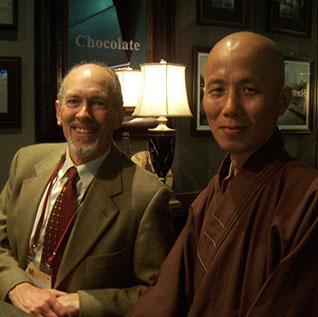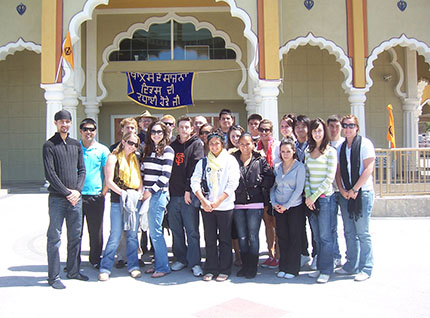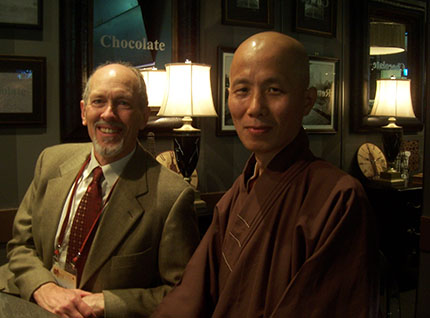
The Public Prayer Life of a Religion Enthusiast
A primary target of the new atheists like Richard Dawkins and Sam Harris is organized religion, which they claim breeds intolerance, mean- spirited incivility, and violence. Thinkers with varying histories on organized religion—for example, Karen Armstrong’s The Case for God, Michael Novak’s No One Sees God: The Dark Night of Atheists and Believers, or Terry Eagleton’s Reason, Faith and Revolution: Reflections on The God Debate—draw on philosophic analysis and critical retrievals of the christian tradition to suggest that the new atheists’ arguments lack intellectual integrity and rigor.
In this essay I pursue a different and certainly more modest response by posing a question: Do the interactions my students and I have with local faith communities and interfaith groups—particularly in those settings where prayer is involved—reveal something that is overlooked by the new atheists, as well as by the increasing number of Americans who appear leery of religion in its institutional forms?
NEW ATHEISTS, NONAFFILIATED, ET AL
When I tell people that I teach religious studies for a living, I often get one of those questions that is less a request for my erudite analysis of an issue, and more the laying of groundwork for the questioner’s opinion. So it was with Conrad, a fellow volunteer with whom I had been paired to scribe the layout of studs, windows, and doors on the frames for interior walls of a new Habitat for Humanity house in Morgan Hill. He asked, “Do you ever talk in your classes about whether organized religion does more harm than good?” He soon told me his position—the harm definitely outweighs the good—which made him wonder why any thinking person would invest time and resources in institutional religion.
I do not count myself among the large number of lapsed Catholics (by Pew’s estimates Catholicism is losing market share at a greater rate than any other denomination, to the point that now one in ten Americans is an ex-Catholic), although I must admit that regular participation in the liturgical and prayer life of my home church has faded recently, so much so that my wife has observed with some irony that I have drifted into the ranks of the unaffiliated.
I suggested to Conrad that he was not alone. Many of my students agree with him. (In a survey of my Winter quarter first-year class, 14 out of 20 students agreed that “religion causes more problems than it solves.”) His position actually has garnered not a little notoriety of late, in the form of the Atheist Bus Campaign. With the support of British new atheist Richard Dawkins, the mobile ads were launched on October 21, 2008, in England and have since spread across Europe and the United States, including my hometown of Des Moines, Iowa.2 The bus campaign began when a British comedy writer, Ariane Sherine, visited a website advertised on a bus. It invited her and her fellow riders to ponder, “When the Son of Man comes, will He Find Faith on Earth?” only to learn she and anyone else who did not accept Jesus as Lord (Matthew 25:41 was cited) would be condemned to hell for eternity. Appealing to the online community, Sherine raised over 150,000 pounds to fund ads on buses with slogans like, “There is no god—deal with it,” “Don’t believe in God? You are not alone,” and “There’s probably no God—now stop worrying and enjoy life.” The campaign, which continues to draw financial support, was designed to counter the unwelcome intrusion of organized religion and its perceived dogmatic intolerance into our public space with pithy and compelling messages inviting us to give up on religion.
Entertained as he was by the bus story, Conrad was adamant that he had no interest in professing atheism; he just wanted nothing to do with organized religion. I again observed that many of my students tended to see things the same way. (In that same class, 11 students reported affiliation with a religious tradition, while 12 reported none.) Conrad’s position is shared by the fastest growing group in America’s religious landscape, according to a recent Pew study. They are the “religiously unaffiliated,” a designation over 16 percent of Americans use to describe their religious leanings. The Pew researchers found that these Americans distrust any form of organized religion, a position they share with the new atheists.
WHERE DO I STAND?
When Conrad asked where I stood on organized religion, I told him that I usually give one of three answers to that question, each of which I qualify. Sometimes I say I stand within Catholicism, my tradition of origin. My qualifier: I do not count myself among the large number of lapsed Catholics (by Pew’s estimates Catholicism is losing market share at a greater rate than any other denomination, to the point that now one in ten Americans is an ex-Catholic), although I must admit that regular participation in the liturgical and prayer life of my home church has faded recently, so much so that my wife has observed with some irony that I have drifted into the ranks of the unaffiliated. Other times I say I stand within what Robert Bellah called enlightenment fundamentalism. But—and here’s my qualifier—I am also persuaded by his argument that this is ultimately an untenable position for someone, like me, who professes to study religion.5 Lately, I explained to Conrad, I’ve taken to describing myself as a religious enthusiast (qualifier: as I will explain below, this term is not without its ambiguity). My enthusiasm relates to the reception I have received from congregations and organizations as I wander about the local community, often accompanied by students, trying to learn what it’s like to be religious in the Silicon Valley.

It is the religious enthusiast in me who thinks I have something of a counternarrative to the distrust, if not disdain, for organized religion among the new atheists, the Atheist Bus Campaign, some of my students, and a growing portion of the American public.
RELIGIOUS DIVERSITY AND PRAYER
In my wanderings about the Valley’s faith communities—which last December extended to the Parliament of World Religions in Melbourne with severacl Santa Clara University students and Associate Campus Minister Aimee Moiso—I’ve had occasion to pray in a variety of different settings. I’ve participated in vespers with Orthodox Christians, evening prayer with Muslims, chanting the Diamond Sutra with Zen Buddhists, singing hymns with Episcopal priests, guided meditation at the Center for Spiritual Enlightenment led by a Catholic laywoman, and the equivalent of laying on of hands with two different Japanese new religious movements.
My students and I have observed Friday prayer at a mosque in Milpitas, unrolled a Torah scroll in San Jose’s oldest synagogue, spent time with an evangelical pastor in his downtown church’s sanctuary, lit candles at the Yom HaShoah (Holocaust memorial observance) hosted annually by the Santa Clara County Board of Supervisors, bathed the Buddha on his birthday with Chinese Buddhists in Sunnyvale, enjoyed langar at the new Sikh gurdwara in San Jose’s Eastside foothills, broken fast during Ramadan with the youth group at the South Bay Islamic Association, and heard practitioners describe their experiences with auditing and e-meters at a Santa Clara Scientology church.
Despite this somewhat dubious religious grounding, I’ve also ventured into interfaith prayer and worship on a number of occasions.
I am humbled and genuinely moved by the generosity of spirit evident in the individuals who open their community’s doors to me and my students to share in what they hold sacred. I—and to a lesser degree, my students—cannot help but come away from these encounters with the beliefs and practices of these various “others” with a measure of enthusiasm for organized religion!
A week at the Parliament of World Religions presented formal and informal opportunities for interfaith prayer; I participate in interfaith prayer at the San Jose mayor’s “faith leaders appreciation breakfast”; and for the past five years I’ve been part of South Bay Interfaith (SBIF).This local organization began sponsoring “public displays of religion” in downtown San Jose’s Circle of Palms in 2005. An Abrahamic Religions celebration of the convergence of holy days that year shared the three traditions’ calls to prayer. In subsequent years that annual event—and the composition of SBIF—has morphed into a celebration of diversity and harmony that draws from over a dozen different traditions. Religious leaders and volunteers from their congregations contribute to each event and share in the preparation of food from around the world. SBIF’s most recent program, New Beginnings: Building a Community of Hope, drew over 400 people to SCU’s campus to commemorate Martin Luther King Jr.’s life and to pray for President Obama on the eve of his inauguration.
My wanderings are not entirely unique. According to a Hartford Seminary study of congregations across the United States, as many as 40 percent partner with other faith communities in service projects, and 20 percent engage in interfaith worship.6 In his 2008 study, Beyond Tolerance: Searching for Interfaith Understanding in America, Gustav Niebuhr chronicles this “mutual curiosity” and interchange between America’s faith communities.
The invidious religious violence around the globe that grabs headlines and provides grist for the new atheists’ mill obscures, Niebuhr believes, the far more important and engaging interactions among persons of faith at the grassroots level. Martin Marty developed a similar insight in his 2005 study of religion in America, When Faiths Collide. He suggests that at a global level there is ample evidence that the boundaries organized religion draws around its communities lead to mutual distrust and demonization of the other. But, Marty goes on, at local levels we find countless examples of religious individuals welcoming and sharing with the stranger those truths and practices that make them who they are.

Niebuhr’s and Marty’s descriptions of the intersections of different faith communities at the local level as “acts of hospitality” capture quite well what I experience in my wanderings about the Silicon Valley’s congregations and interfaith organizations. I am humbled and genuinely moved by the generosity of spirit evident in the individuals who open their community’s doors to me and my students to share in what they hold sacred. I—and to a lesser degree, my students—cannot help but come away from these encounters with the beliefs and practices of these various “others” with a measure of enthusiasm for organized religion!
CAVEAT REGARDING PRAYER LIFE
Do these wanderings constitute a prayer life? A hermeneutics of goodwill might lead me to invoke the historically informed proposal for a world theology that participates in multiple religious traditions made by comparative religions scholar Wilfred Cantwell Smith. Contemporary globalization, he argued, allows us to participate in a historical reality that has been obscured by our tendency to codify religious persons’ faith in separate religious systems. In fact, borrowings and crossings over religious boundaries have been the norm for most of our planet’s religious history; (Smith’s example is the use of prayer beads across several traditions, continents, and eras).9 I could invoke the cross-cultural reflections of Jesuit theologians Peter Phan (“being religious inter-religiously”)10 and Carl Starkloff, S.J. (“syncretism” fashioned after what he observed in North American indigenous Catholic communities).11 Or I could borrow Erik Davis’s proposal that California’s religious landscape—what he describes as a “laboratory of the spirit”—taken as a variegated whole provides a spiritual home, albeit one with “rootless roots,” for postmodern spiritual seekers like him.
But the scholar in me is more inclined toward a hermeneutics of suspicion. Eclecticism is a well-worn path in American religion, going back to Emerson and the Transcendentalists in the mid-19th century. Jack Kerouac turned it into something of a creed in his Mexico City Blues:
I believe in the sweetness of Jesus
And Buddha— I believe
In St. Francis, Avaloki
Tesvara, the Saints
Of First Century India AD
And Scholars Santidevan
And Otherwise Santayanan
Everywhere
While such eclecticism can nurture openness and appreciation for the rich spirituality of diverse traditions, its appropriation of those traditions— as in the case of Beats like Allen Ginsberg—can be shallow, uncritical, and even self-serving. Indeed, my rather undisciplined wanderings could be seen as a blend of America’s individualist and consumerist tendencies, a variation on the ersatz religion of those who profess to be “spiritual but not religious.” Martin Marty critiqued
Indeed, my rather undisciplined wanderings could be seen as a blend of America’s individualist and consumerist tendencies, a variation on the ersatz religion of those who profess to be “spiritual but not religious.”
this stance as one in which “people find meaning without belonging, religions without community. They pick and choose...taking this from science and that from Zen, this from remembered Catholicism and that from hoped for therapy, to form what Margaret Mead in one speech called a ‘mishmash of all the religions ever known.’”14 As much as I hope this is not where my peripatetic prayer life takes me—and sometimes my students—I must admit it is a worry.
BACK TO THE BUS
Even as I vacillate between these two hermeneutics, I do think I am onto something here with my enthusiasm for the organized religions I encounter in my wanderings. While not likely to be converted to see the error of their ways, I suspect the new atheists on the bus will at least have to pause—as have my students, who regularly report a particular visit as a “first” (...time in a synagogue...conversation with a Muslim ...visit to a Sikh gurdwara)—and ponder instances of hospitality, like those that have been extended to me in invitations to pray, learn, converse, sing, and share a meal with my friends and co-religionists, here in the Silicon Valley.
Endnotes
- Karen Armstrong, The Case for God (New York: Knopf Pubplishers, 2009); Michael Novak, No One Sees God: The Dark Night of Atheists and Believers (New York: Doubleday, 2008); Terry Eagleton, Reason, Faith and Revolution: Reflections on the God Debate (New Haven: Yale University Press, 2009).
- Atheist Campaign.org: Official Website of the Atheist Bus Campaign, http://www.atheistbus.org.uk/. See Richard Dawkins’ website, which also chronicles the campaign, and for reference to the Iowa case, see http://richarddawkins.net/ articles/4132.
- Ariane Sherine, “Atheists—Gimme Five,” http://www.guard- ian.co.uk/commentisfree/2008/ju/20/transport.religion; for an overview of its spread across Europe and the USA, see http://www.atheistbus.org.uk/a-quick-international-round- up/.
- The Pew Forum on Religion & Public Life, “Summary of Key Findings” (Report 1: Religious Affiliation), U.S. Religious Landscape Study, http://religions.pewforum.org/ reports.
- Robert N. Bellah, “Confessions of a Former Establishment Fundamentalist,” Bulletin of the Council for the Study of Religion 1, no. 3 (Dec. 1970): 3–6.
- Faith Communities Today, an interfaith research report provided by Hartford Seminary, http://faithcommunitiestoday. org/.
- Gustav Niebuhr, Beyond Tolerance: Searching for Interfaith Understanding in America (New York: Viking Penguin Books, 2008), 90.
- Martin E. Marty, When Faiths Collide (Malden, MA: Black- well Publishing, 2005).
- Wilfred Cantwell Smith, Towards a World Theology: Faith and the Comparative History of Religion (Philadelphia: Westminster Press, 1981).
- Peter C. Phan, Being Religious Interreligiously: Asian Perspectives on Interfaith Dialogue (Maryknoll, NY: Orbis Books, 2004).
- Carl F. Starkloff, A Theology of the In-Between: the Value of Syncretic Process (Milwaukee: Marquette University, 2002).
- Erik Davis, “Envisioning California: An Introduction to THE VISIONARY STATE,” http://www.visionarystate. com/introduction.htm. See Erik Davis, The Visionary State: A Journey Through California’s Spiritual Landscape (photographs by Michael Rauner) (San Francisco: Chronicle Books, 2006).
- Cited in Stephen Prothero, “Introduction,” in Big Sky Mind: Buddhism and the Beat Generation, ed. Carole Tonkinson (New York: Riverhead Books, 1995), 14.
- Martin E. Marty, “Interpreting American Pluralism,” cited in Wade Clark Roof, “CONCLUSION—Faith and Spirituality in a Fluid Environment” in Religion and Public Life in the Pacific Region: Fluid Identities, ed. Wade Clark Roof and Mark Silk (Walnut Creek: AltaMira Press, 2005), 177. Another term from Roof that might apply is “Californication of religion,” which he borrows from Mark Shibley’s Resurgent Evangelicalism in the United States (Columbia: University of South Carolina Press, 1996).